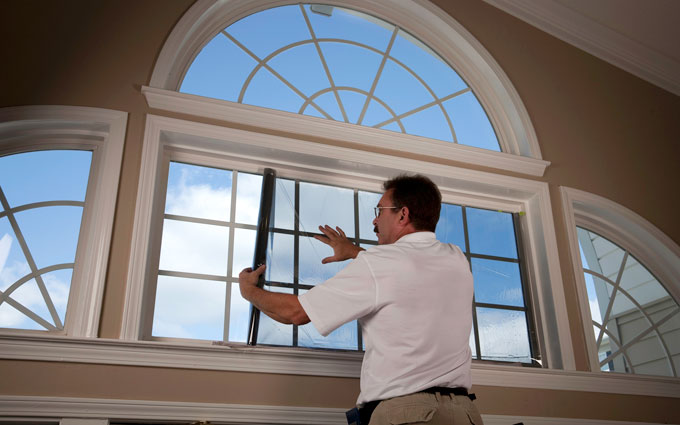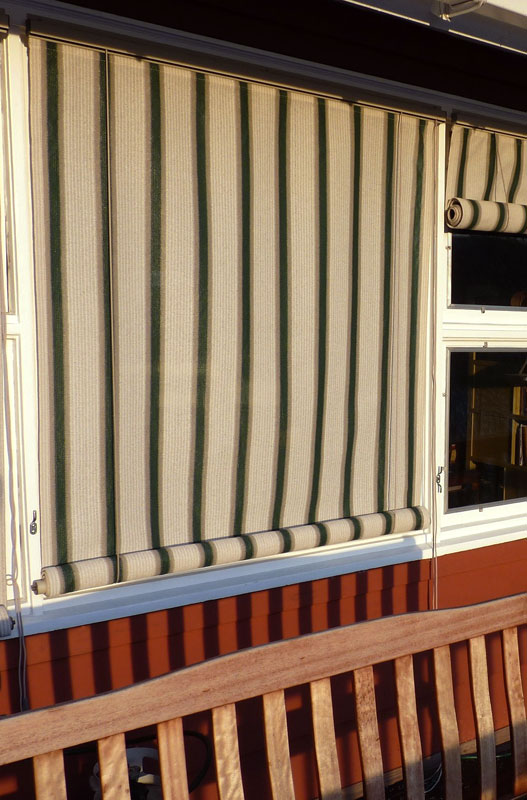Having lived in Europe and with external roller shutters for many years I can say that "from most homeowners' point of view. They look fairly industrial from the outside and completely block light and views from within." is not necessarily true for European style shutters. In today's new construction, the European roller shutters are a part of the window frame and are built into the wall so that when withdrawn they are completely out of sight. Furthermore the slats can be loosely connected so that if partially pulled up, slits of light appear for sufficient inside visibility and some ventilation. Some shutters also run in tracks that can be extended so that the bottom of the shutters protrude from the window for more ventilation.
Blog Post
Keeping the Sun Out: A Guide to Window Attachments

A few weeks ago I told a story in this space that was third-hand from Gordon Hayward. Well, a lot changed in the telling, and Gordon got back to me with what really happened.
Three aunts of a young man from Dorchester, Mass., came up to celebrate his graduation from a Vermont boarding school. They asked Gordon how anyone here ever slept at night: it was so dark and quiet that none of them got a wink. They thought there were at least three bears outside.
This brought up the story of the trip. The whole family, in three cars, left Dorchester in the evening heading for Florida. They got across the Tappan Zee Bridge and onto the New Jersey Turnpike when all of a sudden there were no more streetlights. They pulled into a gas station, had a confab and decided it was too dark--they couldn't proceed--and they turned around and drove home. The crucial detail that I got wrong, says Gordon: "No relative of mine would ever turn back from a dark night, I can assure you."
Out of the sun and into the frying pan
That may be true, but a lot of us are turning away from the sun this time of year. For buildings with windows--which is most of them--retreating inside gets you out of the shade, but it can be hotter and stuffier. Cranking the AC only drives up the power bill.
We use windows to give us views, fresh air, and passive solar heating in the winter, but are there good ways to modify them to prevent too much solar gain in the summer? Yes, and new research from BuildingGreen (my company) and Lawrence Berkeley National Lab (LBNL) tells us which "window attachments" are worth using.
SUPPORT INDEPENDENT SUSTAINABILITY REPORTING
BuildingGreen relies on our premium members, not on advertisers. Help make our work possible.
See membership options »Curtains and drapes block up to 60% of solar gain
Curtains and drapes, the old standby, work pretty well: when installed over clear (uncoated) glass, these attachments alone can block 20%–60% of solar gain (depending on material and color), reducing or preventing the need for air conditioning. For comparison, the highest-performing low-solar-gain windows on the market have an SHGC of 0.20 or lower. While that means that those windows block 80% of solar gain while still permitting a somewhat darkened view, they don't provide much privacy, so many people will still use curtains or blinds.
Combining the two is a good bet: the curtains offer privacy, while the low-SHGC windows block the sunlight before it gets into the house, which is much more effective. One drawback of using curtains or drapes is that you may end up with dark rooms and need to turn on lights, which can cut into energy savings.
Awnings leave the heat outside
Awnings reduce glare without affecting views too much, and they block up to 90% of solar heat gain on south-facing windows--before the heat can come through the window. Awnings also block direct ultraviolet (UV) radiation that can damage upholstery, and they protect the window assembly from the weather.
According to John Gant, sustainable development manager for Glen Raven, maker of Sunbrella exterior shading products, awnings "have a different SHGC depending on indoor and outdoor temperature and the position of the sun" as well as fabric weight and color. In general, a heavier fabric in a darker color will provide more shading. However, Gant cautions that "products from different manufacturers may look the same but perform differently due to the quality of pigments and materials and fabric construction."
Stationary metal awnings are available for homes, but be aware that a fixed exterior attachment works best if orientation, climate, and other factors are taken into account using computer modeling--a service used routinely for commercial buildings but almost never for homes.
Exterior roller shades aid ventilation
Like awnings, exterior roller shades, made of vinyl-coated polyester or fiberglass fabric, block solar heat gain while still allowing a filtered view through the window from the inside. These work much the same way that interior shades do--rolling down in front of the window--but go on the outside of the house.
Exterior shades are generally more effective than interior shades at preventing solar heat gain, providing up to 85% blockage, and tend to offer better ventilation. Similarly, hinged exterior shutters (unlike the common decorative kind) shade the window while allowing ventilation as well as daylight; some hinged shutters can be manipulated with adjustable louvers. Hinged shutters generally block views from the interior, though, and are more popular for weather protection. They may also be more accepted in historic areas and condominium communities, where many new-fangled exterior attachments are not allowed.

One such new-fangled device is an exterior roller shutter. Roller shutters are a multipurpose attachment with hollow or insulated slats that fold neatly when not in use but put the home in thermal, visual, storm, and security lockdown when deployed. Is there anything exterior roller shutters don't do? Unfortunately, yes: the aesthetics leave much to be desired, from most homeowners' point of view. They look fairly industrial from the outside and completely block light and views from within. Though popular in some European countries, exterior roller shutters have only caught on in North America in hurricane and wildfire zones. However, they can be a good solution in extreme climates where air-conditioning loads are very high and shading doesn't go far enough--particularly if home security is also a high priority.
Window film also has a place
If you have windows that are in pretty good shape but don't have a low-e coating, or if you have a great view that you don't want to mar with blinds or awnings, you might consider a solar-control window film. Surface-applied films are rated for solar heat gain and visible transmittance, and NFRC publishes an online list of certified products, making it easier for consumers to make choices. EfficientWindows.org also provides helpful guidance on the wide variety of films available.
Homeowners can install window films themselves, but it is very fussy work. An array of surface-applied films are designed for a variety of jobs: privacy, solar heat rejection, and even winter energy performance.
Costs vary hugely
Costs of window attachments vary hugely. Drapes and curtains, and roller shades, are an affordable option. Surface-applied films are relatively affordable, and then awnings and other fixed attachments can get more expensive--but also deliver a lot of benefits. Check WindowAttachments.org for some great fact sheets.
Also, check out Making Windows Work Better, by Paula Melton and Peter Yost, the recent feature article from Environmental Building News, from where I borrowed some of today's advice.
Do you have windows that aren't quite working for you, but you aren't quite sure how to handle them? Other questions or comments? Let me know.
Published July 26, 2011 Permalink Citation
(2011, July 26). Keeping the Sun Out: A Guide to Window Attachments. Retrieved from https://www.buildinggreen.com/blog/keeping-sun-out-guide-window-attachments



Add new comment
To post a comment, you need to register for a BuildingGreen Basic membership (free) or login to your existing profile.